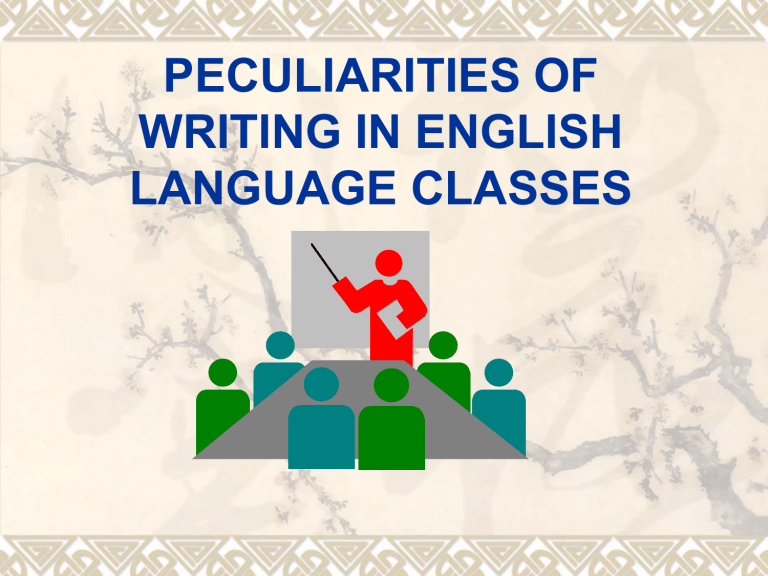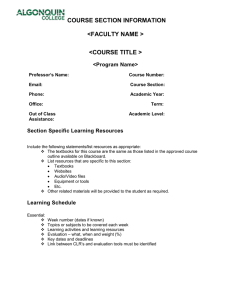
PECULIARITIES OF WRITING IN ENGLISH LANGUAGE CLASSES Teaching objectives By the end of this unit, Ss will be able to: 1. know what, why and how we write 2. know the communicative approach to writing 3. Know the problems in writing tasks in existing textbooks 4. master the process approach to writing 5. design appropriate writing tasks 2 Teaching contents 1. What, why and how do we write? 2. A communicative approach to writing 3. Problems in writing tasks in existing textbooks 4. A process approach to writing; 5. Motivating students to write 6. Designing writing tasks 7 Writing through the Internet 3 1. What, why and how do we write? 1. By writing, students can learn the language and culture; 2. By writing, students can improve their listening, speaking and reading abilities; 3. By writing, students can improve their thinking ability. 4 There is a great variety of things we write in reality, for example, letters, journals, notes, instructions, posters, essays, reports, menus. We write for various reasons, such as to convey messages or just to keep a record of what is in our mind. As to the way we write, we all have our own way. 5 The nature of writing in reality Comparing writing in our English teaching classroom with writing in reality: First, writing in the ELT classroom (also as homework) is often seen as a means to consolidate language that is recently studied. Second, the teacher gives a topic or a selection of topics, a set of requirements, and a time limit. The students finish the task within the time limit and hand in the final product. 6 2. A communicative approach to writing Communication writing means either writing for a specific recipient, e.g. writing a letter to a friend or parent, or engaging in an act of creative writing where their work is intended to be read by other people, in other words, an intended audience. Communication writing is authentic writing tasks that have some communicative elements. 7 2. A communicative approach to writing Writing activities can be between “writing for learning” and “writing for communication”: Activities 1--6 8 3. Problems in writing tasks in existing textbooks The deficiencies of writing tasks in existing English textbooks : 1.They are mainly accuracy-based. 2.They are designed to practise certain target structures. 3.There is insufficient preparation before the writing stage. 4.There is no sense of audience. 9 3. Problems in writing tasks in existing textbooks 5.There is no sense of authenticity. 6.Students are given ideas to express rather than being invited to invent their own. 7.There is no opportunity for creative writing, particularly for expressing unusual or original ideas. 8.The influence from Chinese. 10 4. A process approach to writing Features of process writing: • Focus on the process of writing that leads to the final written product; • Help student writers to understand their own composing process; • Help them to build repertoires of strategies for prewriting, drafting, and rewriting; • Give students time to write and rewrite; • Place central importance on the process of revision; 11 4. A process approach to writing • Let.students discover what they want to say as they write; • Give students feedback throughout the composing process (not just on the final product) to consider as they attempt to bring their expression closer and closer to intention; • Encourage feedback both from the instructor and peers; • Include individual conferences between teacher and student during the process of composition. 12 4. A process approach to writing The main procedures of process writing includes: Creating a motivation to write Brainstorm Mapping Freewriting Outlining Drafting Editing Revising Proofreading Conferencing 13 5 Motivating students to write Task 8 on p221: Work in groups and discuss how teachers can motivate students to write. Work out a list of principles and share it with another group 14 6. Designing writing tasks Work in pairs and design an interesting writing task and write an detailed teaching plan for your writing task. 15 7 Writing through the Internet E-mail provides a perfect mechanism for students to submit drafts and for teachers to look them over at their convenience and send them back with comments — once, twice, or several times. New ideas are shared promptly and can be responded to quickly. Another advantage is that the teacher can easily store all the drafts of a document for later review and analysis of the revision process. All these help to promote the application of the process approach to writing in the ELT classroom. 16 Assignments Review the text & do all the exercises; 17



